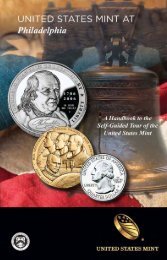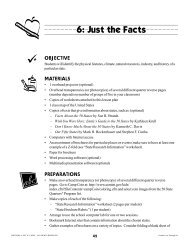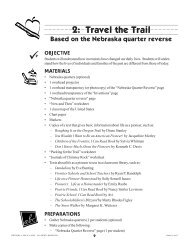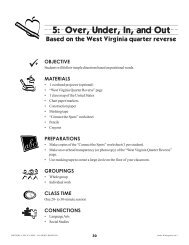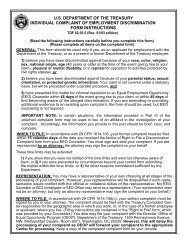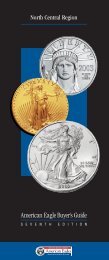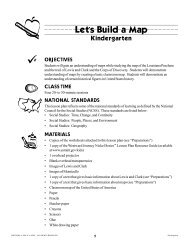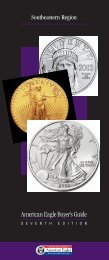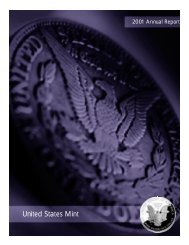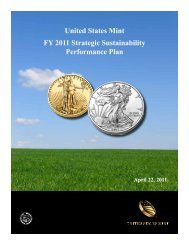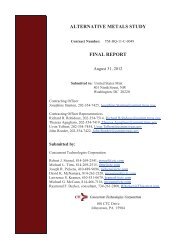United States Mint 50 State Quarters⢠Program - The United States ...
United States Mint 50 State Quarters⢠Program - The United States ...
United States Mint 50 State Quarters⢠Program - The United States ...
- No tags were found...
You also want an ePaper? Increase the reach of your titles
YUMPU automatically turns print PDFs into web optimized ePapers that Google loves.
<strong>The</strong> Greatest Educational Change America Has Ever SeenLesson Plans for Grades 4-6Recognizing the Shape of the USA and Home <strong>State</strong>Table of ContentsOBJECTIVE:Start with a ChartUsing informationgathered froma chart.I Have, Who Has?Identifying statesand their capitals.In the News!Conductingresearch andwriting amini-report.CURRICULUMCONNECTIONS:• Mathematics• U.S. History• Language Arts• U.S. Geography• U.S. History• Language Arts• U.S. Geography• U.S. History• Language Arts• ArtGROUPINGS: CLASS TIME: PAGES:Individual 1 class period 2-5Whole groupSmall groups1 class period 6-9Individual 3 class periods 10-13Worth the WeightProblem solving withmetric measurement.Take a ChanceDetermining theprobability ofa given event.• Mathematics• ScienceUsing a Coordinate GridPlotting pointson a coordinategrid.• Mathematics• U.S. History• Art• Mathematics• U.S. History• Language ArtsSmall groupsIndividualSmall groupsIndividualPartnerWhole groupSmall groupsIndividual1-2 class periods 14-172 class periods 18-211 class period 22-25ADDITIONAL RESOURCES<strong>State</strong> Information Pages:<strong>50</strong> <strong>State</strong> Quarters Released in 1999—Delaware, Pennsylvania, New Jersey, Georgia, Connecticut . . . . . . . . . . . . 26-27<strong>50</strong> <strong>State</strong> Quarters Released in 2000—Massachusetts, Maryland, South Carolina, New Hampshire, Virginia . . . . . 28-29<strong>United</strong> <strong><strong>State</strong>s</strong> of America Map Template . . . . . . . . . . . . . . . . . . . . . . . . . . . . . . . . . . . . . . . . . . . . . . . . . . . . . . . . . . . . . 30Reproducible Coin Sheets . . . . . . . . . . . . . . . . . . . . . . . . . . . . . . . . . . . . . . . . . . . . . . . . . . . . . . . . . . . . . . . . . . . . . . . . 31-32<strong>50</strong> <strong>State</strong> Quarters <strong>Program</strong> Release Schedule . . . . . . . . . . . . . . . . . . . . . . . . . . . . . . . . . . . . . . . . . . . . . . . . . . . . . . 33Lesson plans and other related <strong>50</strong> <strong>State</strong> Quarters <strong>Program</strong> materials are provided solely for teaching purposes.<strong>The</strong>y may not be commercially distributed or distributed as a premium.© 2000 U.S. MINT ALL RIGHTS RESERVED
Teacher’s Pages1: Start with a ChartOBJECTIVE:<strong>The</strong> student will synthesize information gathered from a chart. <strong>The</strong> studentwill choose a mathematical technique to answer questions involvingaddition, subtraction, and ordering of dates.MATERIALS:• Copies of the “Start with a Chart” worksheet (page 4), oneper student• Copies of the “<strong><strong>State</strong>s</strong> and Quarters Questions” worksheet(page 5), one per student• Paper• PencilPREPARATIONS:• Review lesson.• Review chart and worksheet.GROUPING:• Individual workCLASS TIME:• 1 class periodCONNECTIONS:• Mathematics• U.S. History• Language ArtsTERMS and CONCEPTS:• <strong>State</strong>hood• Issuance• <strong>50</strong> <strong>State</strong> Quarters <strong>Program</strong>2© 2000 U.S. MINT ALL RIGHTS RESERVED
Teacher’s PagesUsing a Chart to Gather InformationSTEPS:1. Discuss the new <strong>50</strong> <strong>State</strong> Quarters <strong>Program</strong> with students, a new coin programby the U.S. <strong>Mint</strong>. Approximately every 10 weeks, the U.S. <strong>Mint</strong> is releasing aspecial quarter for each state, in the order the states were admitted into the<strong>United</strong> <strong><strong>State</strong>s</strong>. Each new quarter possesses a unique design that celebrates thatstate’s heritage and special contribution to the <strong>United</strong> <strong><strong>State</strong>s</strong>.2. Provide students with necessary materials (paper, pencil, etc.).3. Pass out the “Start with a Chart” worksheet (page 4) and the “<strong><strong>State</strong>s</strong> andQuarters Questions” worksheet (page 5).4. Have students use paper and pencil to answer the questions on theworksheet while referring to the chart for their answers.5. Evaluation can take place as the teacher checks students’ work forunderstanding.ANSWER KEY:1. 20082. 53. In the same sequenceas they were grantedstatehood4. Varies5. Varies6. 1788 (8)7. 47 years (between1912 and 1959)8. Alaska and Hawaiiin 19599. a. Delawareb. Virginiac. Arkansasd. Nebraskae. Idaho10. Varies11. 1959–1787=172 years12. Oregon andArizona13. a. Nob. A year and 6months14. VariesENRICHMENT/EXTENSIONS:Students can create their own list of questions in reference to the chartand exchange with another student.Students can design a quarter for their home state.3© 2000 U.S. MINT ALL RIGHTS RESERVED
NameDateStart with a ChartDIRECTIONS:Review the chart below to answer the questions on the “<strong><strong>State</strong>s</strong> and QuartersQuestions” worksheet.<strong>State</strong>hood Date1999 . . . . . . . . . . . . . . . . .Delaware . . . . . . . . December 7, 1787Pennsylvania . . . . . December 12, 1787New Jersey . . . . . . . December 18, 1787Georgia . . . . . . . . . January 2, 1788Connecticut . . . . . . January 9, 17882000 . . . . . . . . . . . . . . . . .Massachusetts . . . . . February 6, 1788Maryland . . . . . . . . April 28, 1788South Carolina . . . May 23, 1788New Hampshire . . . June 21, 1788Virginia . . . . . . . . . June 25, 17882001 . . . . . . . . . . . . . . . . .New York . . . . . . . . July 26, 1788North Carolina . . . November 21, 1789Rhode Island . . . . . May 29, 1790Vermont . . . . . . . . . March 4, 1791Kentucky . . . . . . . . June 1, 17922002 . . . . . . . . . . . . . . . . .Tennessee . . . . . . . . June 1, 1796Ohio . . . . . . . . . . . March 1, 1803Louisiana . . . . . . . . April 30, 1812Indiana . . . . . . . . . December 11, 1816Mississippi . . . . . . . December 10, 18172003 . . . . . . . . . . . . . . . . .Illinois . . . . . . . . . . December 3, 1818Alabama . . . . . . . . . December 14, 1819Maine . . . . . . . . . . March 15, 1820Missouri . . . . . . . . . August 10, 1821Arkansas . . . . . . . . . June 15, 1836<strong>State</strong>hood Date2004 . . . . . . . . . . . . . . . . .Michigan . . . . . . . . January 26, 1837Florida . . . . . . . . . . March 3, 1845Texas . . . . . . . . . . . December 29, 1845Iowa . . . . . . . . . . . . December 28, 1846Wisconsin . . . . . . . May 29, 18482005 . . . . . . . . . . . . . . . . .California . . . . . . . . September 9, 18<strong>50</strong>Minnesota . . . . . . . May 11, 1858Oregon . . . . . . . . . February 14, 1859Kansas . . . . . . . . . . January 29, 1861West Virginia . . . . . June 20, 18632006 . . . . . . . . . . . . . . . . .Nevada . . . . . . . . . . October 31, 1864Nebraska . . . . . . . . March 1, 1867Colorado . . . . . . . . August 1, 1876North Dakota . . . . . November 2, 1889South Dakota . . . . . November 2, 18892007 . . . . . . . . . . . . . . . . .Montana . . . . . . . . November 8, 1889Washington . . . . . . November 11, 1889Idaho . . . . . . . . . . . July 3, 1890Wyoming . . . . . . . . July 10, 1890Utah . . . . . . . . . . . . January 4, 18962008 . . . . . . . . . . . . . . . . .Oklahoma . . . . . . . November 16, 1907New Mexico . . . . . . January 6, 1912Arizona . . . . . . . . . February 14, 1912Alaska . . . . . . . . . . . January 3, 1959Hawaii . . . . . . . . . . August 21, 19594© 2000 U.S. MINT ALL RIGHTS RESERVED
NameDate<strong><strong>State</strong>s</strong> and Quarters QuestionsDIRECTIONS:Answer the questions below referring to the“Start with a Chart” sheet.1. In whatyear will the<strong>50</strong> <strong>State</strong>Quarters <strong>Program</strong>be complete, withall the quarters incirculation?2. How many quartersare issued eachyear?3. In what order arethe quarters beingissued?4. How oldwill yoube whenthe <strong>50</strong> <strong>State</strong>Quarters<strong>Program</strong> is complete?______________________________________________________________________________________________5. Whatgradewillyou bein when the programis complete?6. In what year were themost states admittedto the <strong>United</strong> <strong><strong>State</strong>s</strong>?________________________7. What was the longestperiod of time whenthere were no statesadded to the country?8. What were the lasttwo states to beadded to the <strong>United</strong><strong><strong>State</strong>s</strong>?_______________________How many states wereadmitted that year?_______________________What year were theyadded?_____________________________________________________________________________________________9. Name the following states:1st state __________________________10th state __________________________25th state __________________________37th state ___________________ _______43rd state ___________________________10. In whatyear wasyourhome stateadmittedinto the <strong>United</strong> <strong><strong>State</strong>s</strong>?________________________11. How many years didit take for all <strong>50</strong>states to becomethe <strong>United</strong> <strong><strong>State</strong>s</strong> ofAmerica?________________________12. Whichstateswereadmittedto the <strong>United</strong> <strong><strong>State</strong>s</strong>on Valentine’s Day?13. Did NorthCarolina andSouth Carolinabecome states atthe same time?If not, how manyyears apart werethey admitted to the<strong>United</strong> <strong><strong>State</strong>s</strong>?14. How long after thefirst state was yourstate admitted tothe <strong>United</strong> <strong><strong>State</strong>s</strong>?_______________________________________________________________________________________________________5© 2000 U.S. MINT ALL RIGHTS RESERVED
Teacher’s Pages2: I Have, Who Has?OBJECTIVE:<strong>The</strong> students will learn states and their capitals, improving their knowledgeof geography.MATERIALS:• Copies of reproducible “I Have, Who Has?” cards (pages 8 and 9),one set of 12 cards per group (12 students or fewer)• Copies of the “<strong>United</strong> <strong><strong>State</strong>s</strong> of America Map Template” study sheet(page 30), one per studentPREPARATIONS:• Review list of states and their capitals.• Make “I Have, Who Has?” cards by copying pages 8 and 9front-to-back and cutting cards on the dotted line.• Write state names on the “I Have” side of the cards.• Write state capitals at random on the “Who Has?” side of the cards.• Laminate cards, if desired.GROUPING:• Whole group/small groups (12)CLASS TIME:• Two class periods, the first to review states’ capitals,the second to play the game.• During the second class period, each round of the game shouldtake about 10 minutes.CONNECTIONS:• U.S. Geography• U.S. History• Language ArtsTERMS and CONCEPTS:• <strong><strong>State</strong>s</strong>• Capitals6© 2000 U.S. MINT ALL RIGHTS RESERVED
Teacher’s PagesA Review of <strong><strong>State</strong>s</strong> and <strong>The</strong>ir CapitalsSTEPS:1. Distribute the “<strong>United</strong> <strong><strong>State</strong>s</strong> of America Map Template” study sheet (page 30) and havestudents review the list of states and capitals.2. Let students know that during the next class period they will play a game to review statesand their capitals. Remind students to take their study sheet home with them.3. During the next class period, explain the game procedure, provided below. Give ademonstration, if necessary.4. Divide the class into groups of 12 or fewer. Give each group one set of “I Have, WhoHas?” cards. <strong>The</strong> students should pass out the cards to the group, one per student.For groups with fewer than 12 students, some students may receive more than one card.5. Students should play the game, as instructed. Cards can be shuffled, and the game canbe replayed. It is also possible to reverse the game so that students use the “I Have” sideof the card first (naming the state), and then must identify the correct state capital on the“Who Has?” side of the card.6. You may wish to time the games to test students’ progress, or hold a competition betweengroups.7. To assess whether or not the students have learned the material, a quiz can be given.In most cases, students have an easier time determining the state when given the statecapital, rather than vice versa.DIRECTIONS FOR “I Have, Who Has?”:• Students place his or her cards “Who Has?” face down on the table.• Choose a member of the group to go first.• <strong>The</strong> game begins when the first player reads the state capital from the “Who Has?”side of his or her card; e.g., “Who has Richmond?”• Students will then look at the “I Have” sides of their cards. <strong>The</strong> student who has thecard with the corresponding state will read the “I Have” side of his or her card; e.g.,“Ihave Virginia.” <strong>The</strong>n, he or she will turn the card over and read the “Who Has?” sideof the card.• <strong>The</strong> student with the corresponding state will respond, and the game will continue inthis manner until all cards have been read.ENRICHMENT/EXTENSIONS:“I Have, Who Has?” card templates have been provided on pages 8 and 9. Students can make“I Have, Who Has?” for all <strong>50</strong> states and play the game for review.Students can create a crossword puzzle with the state names and capitals.Students can create and play a game of concentration with states and capitals.7© 2000 U.S. MINT ALL RIGHTS RESERVED
Teacher’s Pages/“I Have, Who Has?” Game Cards“I Have, Who Has?”8© 2000 U.S. MINT ALL RIGHTS RESERVED
Teacher’s Pages/“I Have, Who Has?” Game CardsGame Cards9© 2000 U.S. MINT ALL RIGHTS RESERVED
Teacher’s Pages3: In the News!OBJECTIVE:Students will write a “newspaper article” comparing their state to another state,learning how to research information, take notes, organize material, and proofread.MATERIALS:• Reference resources (encyclopedias, atlases, maps, dictionaries, andother reference materials)• Copies of the “What’s the Scoop?” sheet (page 12), one per student• Copies of the newspaper article template (page 13), one per student or asmany as needed• A notebook• Pens/pencils• Markers or colored pencils for illustrationsPREPARATIONS:• Copy “What’s the Scoop?” (page 12) to guide students in their research.• Copy newspaper article template (page 13).• Assign a different state to each student.• Make reference resources available, and schedule time inthe library for research.• Provide markers/colored pencils for students to use in illustrations.GROUPING:• Individual workCLASS TIME:• Two to three class periods, or time to complete article at home.CONNECTIONS:• Language Arts• U.S. History• U.S. Geography• ArtTERMS and CONCEPTS:• Boundaries• Climate• Natural resources• <strong>State</strong>hood• <strong>State</strong> nicknames/mottoes• Population• Symbols10© 2000 U.S. MINT ALL RIGHTS RESERVED
Teacher’s PagesA Mini-Research Project on the Unique Characteristics of a <strong>State</strong>STEPS:1. Explain to students that they are going to become reporters for theQuarterly News and write a newspaper article on a state.2. Hand out the “What’s the Scoop?” worksheet (page 12). (It is not necessary thatstudents answer all questions on the list.)3. Have the students keep notes in which they compile the results of their research.4. Allow students time in class or at the library to work on the project. Youmay also wish to assign time at home for them to complete the assignment.5. Once students are finished researching information and taking notes, have themwrite a one- to two-page draft of the article.6. Remind students that the article needs a headline and some sort of illustrationor picture of the quarter they are researching. Students may also include anillustration or picture of the state flower, the state bird, the shape of the state,the state flag, or any other unique landmark or physical feature.7. Work with students individually or in groups to help them edit their drafts forgrammar, capitalization, spelling, punctuation, and clarity.8. Have students write his or her final draft on a copy of the newspaper articletemplate (page 13) in his or her best handwriting or on a computer.9. Bind the final reports together into one “newspaper” and have studentsdiscuss possible names for it.10. Students should be graded on the quality and accuracy of their information;their writing proficiency, including grammar, capitalization, spelling, punctuation,and neatness; their artwork; and the overall effort they have put into their reports.It may be a good idea to require students to hand in their research worksheets(page 10) as well.ENRICHMENT/EXTENSIONS:Students can share their reports with the class in an oral presentation.Students can look for more in-depth resources on the state they researched, andwrite a “biography” of a famous American from that state.11© 2000 U.S. MINT ALL RIGHTS RESERVED
NameDateWhat’s the Scoop?DIRECTIONS:Good reporters ask good questions that guide them on their search for information. Usethe following list of questions to guide you in your research of your assigned state. Your notes should beshort but thorough, so that you can get down as much information as you can in as short a time aspossible. Remember that good notes lead to good stories and articles!1. What is the state’s name?___________________________________________2. What is the name of its capital?___________________________________________3. In what year did it receive its statehood?___________________________________________4. In what year will this state’s new quarterbe issued? __________________________________5. a. Who founded this state?________________________________________b. How did the <strong>United</strong> <strong><strong>State</strong>s</strong> acquirethis land? _________________________________________________________________ ______6. What is the state flower?_____________________7. What is the state bird? __________ ____________8. Name three historic facts regarding this state.__________________________ _________ _____________________________________________________________________________________________9. Draw the state symbol and describe what itrepresents.___________________________________________10. What is the state motto and what does it mean?______________________________________________________________________________________1211. a. What is the state nickname?__________ ______________________________b. Why was it given that name?__________ ______________________________12. Is this state larger or smaller than yourstate?____________________________________13. Name all the states, countries, and/or bodiesof water that border this state.____________________________________________________________________________________14. a. What is the state population?________________________________________b. Is that more or less than your state?________________________________________15. a. What are the state’s chief natural resources?________________________ ____ ______________________________________ ____________b. What types of industries is this state knownfor? ____________________________________________________________________________16. a. What kind of climate does this state have?________________________ ________________________________________________________b. How does that compare to your state?________________________________________17. What are three tourist attractions in thisstate?________ ______________________________________________________________________18. List three facts you find interesting about thisstate: _______________________________________________________________________________© 2000 U.S. MINT ALL RIGHTS RESERVED
Today’s date is: __________________________Just the facts about_______________________________<strong>The</strong> new quarters are the greatesteducational change America has ever seen!13© 2000 U.S. MINT ALL RIGHTS RESERVED
Teacher’s Pages4: Worth the WeightOBJECTIVE:<strong>The</strong> student will convert metric units of measurement. <strong>The</strong> student will solveproblems that involve addition, subtraction, multiplication, and/or division withdecimals, as well as order decimals from least to greatest.MATERIALS:• Copies of the “Worth the Weight” chart and questions (pages 16 and 17),one per student• Calculator• Paper• Pencil• Metric scale or metric ruler (optional)PREPARATIONS:• Copies of the “Worth the Weight” chart and questions (pages 16 and 17),one per student.• Read through lesson.• Set up metric scale (if available).GROUPING:• Individual/small groupsCLASS TIME:• One to two class periodsCONNECTIONS:• Mathematics• ScienceTERMS and CONCEPTS:• Grams• Millimeters• Centimeters• Diameter14© 2000 U.S. MINT ALL RIGHTS RESERVED
Teacher’s PagesA Lesson in Metric Measurement and Problem SolvingSTEPS:1. List lesson terms on the board and discuss metric units of measurement.2. Give students a mental comparison: for example, a gram is a metric unit measurementof weight approximately equal to the weight of a paper clip, or 1 inch isabout 2.5 centimeters.3. Review the measurement of length using the metric units millimeters andcentimeters.4. Review with students that 10 millimeters equals 1 centimeter. Demonstrate how toconvert millimeters to centimeters either by dividing the number of millimeters by10 (example 22.56mm/10 = 2.256cm), or by using a short-cut of moving the decimalone space to the left when converting from a smaller unit of measurement to alarger unit of measurement.5. Demonstrate how to measure the width of a piece of paper by lining up the coinsand adding their diameters. Hand out “Worth the Weight” worksheets(pages 16 and 17) and review directions.6. Students will be evaluated by checking for accuracy in their work. Review students’work and quiz them for understanding of the concepts presented in the lesson.ANSWER KEY:Chart:1. Cent: 1.905, 0.155Nickel: 2.121, 0.195Dime: 1.791, 0.135Quarter: 2.426, 0.175Half-dollar: 3.061, 0.215Golden Dollar: 2.6<strong>50</strong>,0.201Weight:1. Dime, cent, nickel,quarter, Golden Dollar,half-dollar2. 2 dimes3. 2 nickels4. a. 0.670 gramsb. 3.402 gramsc. 3.17 grams5. Varies6. VariesThickness:1. Dime, cent, nickel,quarter, Golden Dollar,half-dollar2. 32 cents, 23 half-dollars3. 1.957cm, $3.134. <strong>50</strong> quarters, 100 dimesDiameter:1. Dime, cent, nickel,quarter, Golden Dollar,half-dollar2. String A, String B3. 9 quarters, 12 dimes,11 cents (with an8 1 ⁄2 x 11 sheet of paper)NOTE: Answers are thesame in centimeters orinches.ENRICHMENT/EXTENSIONS:Students can come up with an additional five questions related to the information found in thechart, and then quiz a classmate for extra credit.Students can weigh the coins using a metric measuring device or convert the measurements intoU.S. customary units of measurement.15© 2000 U.S. MINT ALL RIGHTS RESERVED
NameDateWorth the Weight—Part 1DIRECTIONS:Convert the measurements from millimeters to centimeters for both the diameterand thickness columns in the space provided in the chart.Coin DenominationWeightDiameterin InchesDiameter inMillimetersThicknessCent2.<strong>50</strong>0grams0.7<strong>50</strong>inches19.05 mm______ cm1.55 mm______ cmNickel5.000grams0.835inches21.21 mm______ cm1.95 mm_____ cmDime2.268grams0.705inches17.91 mm______ cm1.35 mm_____cmQuarter5.670grams0.955inches24.26 mm______ cm1.75 mm_____ cmHalf-Dollar11.340grams1.205inches30.61 mm______ cm2.15 mm_____cmGoldenDollar8.100grams1.043inches26.<strong>50</strong> mm______ cm2.01 mm_____cm1610mm =© 1999-2000 U.S. <strong>Mint</strong> All Rights Reserved
NameDIRECTIONS: Refer to the “Worth the Weight” chart to help you answer thefollowing questions.Questions Regarding Weight:1. Order the coins according totheir weight from least to greatest.1.)_________________ 4.)__________________2.)_________________ 5.)_____________ ____3.)_________________ 6.)__________________2. Approximate the number of dimes it would taketo equal the weight of 1 quarter. _______ dimesDateWorth the Weight—Part 22. About how many cents would it take to make astack 5 centimeters high?_______ centsHow many half-dollars?_______ half-dollars3. If you stacked 2 Golden Dollars, 4 quarters,2 nickels, and 3 cents, how high would your stackbe in centimeters?_______ cmHow much money would you have?$_________3. About how many nickels would it take to equalthe weight of a Golden Dollar?_______ nickels4. About how much more does a quarterweigh than:a.) A nickel; _____________ gmb.) A dime; _____________ gmc.) A cent; _____________ gm5. List three coin combinations for a dollar andinclude the total weight for each combination.1.)____________________________ ________ gm2.)____________________________ ________ gm3.)____________________________ ________ gm6. What coin combination for a dollar would be the:Heaviest? _____________________________________________________________________________Lightest? _____________________________________________________________________________Questions Regarding Thickness:1. Place the coins in order of their thickness fromleast to greatest.1.)_________________ 4.)__________________2.)_________________ 5.)_____________ ____3.)_________________ 6.)__________________4. Which stack would be more valuable: a stackof 100 dimes or a stack of <strong>50</strong> quarters?Circle: Dimes or QuartersWhich stack would be higher?Circle: Dimes or QuartersQuestions Regarding Diameter:1. Arrange the coins by their diameter from leastto greatest.1.)_________________ 4.)__________________2.)_________________ 5.)_____________ ____3.)_________________ 6.)__________________2. If you have two strings of coins such as:String A: 3 quarters, 4 nickels, and 8 cents, andString B: 1 Golden Dollar, 1 half-dollar, and5 dimes, and you laid them side by side,a.) Which set would be longer?Circle: String A or String Bb.) Which set would be more valuable?Circle: String A or String B3. If you were to measure the width of this piece ofpaper laying the coins side by side:a.) About how many quarters would it take? _____b.) About how many dimes? ________c.) About how many cents? ________Hint! An 8 1 ⁄2 inch sheet of paper ≈ 21.5cm 17© 2000 U.S. MINT ALL RIGHTS RESERVED
Teacher’s Pages5: Using a Coordinate GridOBJECTIVE:<strong>The</strong> student will manipulate ordered pairs in the first quadrantof a coordinate plane.MATERIALS:• “Coordinate Grid” worksheet (page 20), one per student• Paper• Pencil• “Enlarge a Quarter” worksheet (page 21), one per student• One picture of a quarter, enlarged (see “Reproducible CoinSheets,” pages 31 and 32)• Markers or crayons• RulersPREPARATIONS:• Copy the “Coordinate Grid” worksheet (page 20) and the “Enlargea Quarter” worksheet (page 21).• Enlarge a picture of a quarter for display.• Using a ruler, draw a grid over the quarter with a black marker.GROUPING:• Small groups/partner work• Individual workCLASS TIME:• Two class periodsCONNECTIONS:• Mathematics• U.S. History• ArtTERMS and CONCEPTS:• Coordinate grid• Ordered pairs• Vertical• Coordinate plane• Horizontal18© 2000 U.S. MINT ALL RIGHTS RESERVED
Teacher’s PagesA Lesson Demonstrating Grids and Ordered NumbersSTEPS:1. Put list of terms on the board and review definitions.2. Demonstrate that finding an ordered pair on a grid (5,4) would be 5 overto the right (horizontally) and 4 up (vertically). Pass out the “CoordinateGrid” worksheet (page 20) and ask students to complete it.3. Display the enlarged picture of the quarter with the grid. Demonstrate how toenlarge the picture on the board as follows:a. Measure the distance between grid lines.b. Multiply the distance between grid lines by three, and draw alarger grid on the board.c. Transfer the image from the paper to the board by drawing the contentsof each grid block in the appropriate box on the board.4. Distribute the “Enlarge a Quarter” worksheet (page 21). Have students use apencil and a ruler to draw in grid lines (to make a grid five boxes across, and fiveboxes down, gridlines should be three centimeters apart). NOTE: For youngerstudents, you may wish to draw in gridlines before copying sheets.5. Students will enlarge the picture, using the grid as a guide.6. Students can erase the grid lines, and then color in their picture.<strong>The</strong>se pictures can be displayed in the classroom.ANSWER KEY:What do you call a person who collects coins? NUMISMATISTENRICHMENT/EXTENSIONS:Students can create a picture (e.g., a tree, a star) or design made up of points plottedon a grid, and determine the ordered pair for each point. <strong>The</strong> student can then read the orderedpairs to a partner, who will plot them on a grid, connecting the dots to achieve the same picture.Students can create their own coordinate grid puzzle, like that on page 20. Students can write aquestion referring to some aspect of the lesson, and then “hide” the answer in a grid. By assigninga letter to various points in the grid, and then listing the ordered pairs in the correct order,students will make a puzzle for a partner to decipher.19© 2000 U.S. MINT ALL RIGHTS RESERVED
Name DateUsing a Coordinate GridDIRECTIONS:Below is a list of ordered pairs. Find the exact point for each set of ordered pairs. At eachpoint, there is a letter. As you find each point, write down the letter in the space provided:What do you call a person who collects coins?(1,3) (7,7) (2,8) (6,1) (4,3) (5,0) (8,1) (5,2) (0,6) (3,3) (8,4)20© 2000 U.S. MINT ALL RIGHTS RESERVED
NameDateEnlarge a QuarterDIRECTIONS:First, figure out how many times bigger the picture can be tofit in the large box below. Using a pencil, draw grid lines forthe large box. <strong>The</strong>n, use these grid lines to help you enlargethe picture to fit the box. When you are finished, you canerase the gridlines and color your quarter.Hint: <strong>The</strong> white box is 15cm tall by 15cm wide.21© 2000 U.S. MINT ALL RIGHTS RESERVED
Teacher’s Pages6: Take a ChanceOBJECTIVE:<strong>The</strong> student will determine the probability of a given event using concreteexamples. Students will describe events using terms such as “likely,”“unlikely,” “certain,” and “impossible.” <strong>The</strong> student will convertfractions to decimals, decimals to percents, and percents to fractions.MATERIALS:• Several bags with 8 quarters (each can use real coins or cut out coinsfrom the “Reproducible Coin Sheets,” pages 31 and 32):◆1 eagle quarter◆ 7 new quarters: (All 5 from 1999 and any two from 2000)• Paper• Pencil• Calculator (optional)• “Take a Chance” worksheets (pages 24 and 25), one per studentPREPARATIONS:• Prepare coins (either real or cut outs from pages 31 and 32).• Write key terms on the board (likely, unlikely, certain,and impossible).• Pass out “Take a Chance” worksheets (pages 24 and 25).GROUPING:• Small groups/entire class• Individual work (optional)CLASS TIME:• 1 class periodCONNECTIONS:• Mathematics• U.S. History• Language Arts22© 2000 U.S. MINT ALL RIGHTS RESERVED
Teacher’s PagesA Lesson on ProbabilityTERMS and CONCEPTS:• Probability • Likely • Unlikely• Impossible• CertainSTEPS:1. Introduce the activity by asking students if they have ever played a gameinvolving chance. What is another name for “chance”? What does the word“probability” mean?2. Discuss various games and determine if they involve chance or strategy.3. Discuss terms on board. Define as a class.4. Pass out bags of quarters (real or paper) and the “Take a Chance” worksheets(pages 24 and 25). Students may work in groups or as a whole class depending onteacher preference. Have students examine the contents of the bags.5. Review the process for changing fractions to decimals, decimals to percents, andpercents to fractions.6. As a warm-up, have students determine the probability of pulling the eaglequarter out of the bag. Have students write the outcome as a fraction (1/8).7. Students will complete the “Take a Chance” worksheets (pages 24 and 25).8. Check worksheet answers for accuracy. Quiz students on concepts learnedto verify understanding.ANSWER KEY:1. 1/82. 7/83. 5/84. 2/8 or 1/45. 6/8 or 3/46. 7/87. 1/88. 09. 8/8 or 110. 3/81. Likely2. Unlikely3. Certain4. ImpossibleENRICHMENT/EXTENSIONS:Students can invent a game of chance to play with classmates.Students can generate a quiz testing the new vocabulary terms/definitionslearned in the lesson.23© 2000 U.S. MINT ALL RIGHTS RESERVED
NameDateTake a Chance—Part 1DIRECTIONS: You are given a bag of eight quarters containing one eagle quarter(made prior to 1999), five new quarters from 1999, and two new quarters mintedin 2000. Pulling out one quarter at a time and then returning the quarter to thebag, what would be the probability (in fraction form) of choosing:2. A newquarter?3. A quarterminted in1999?4. A quarterminted in2000?5. A quartermintedbefore2000?1. An eaglequarter?Hint: Remember to reduce fractions.6. A quarterminted in2000 or1999?7. A quartermintedbefore1999?9. A quarter? 10. A quarternot mintedin 1999?8. A cent?Fill in the blank with one of the following terms:Likely, Unlikely, Impossible, Certain1. <strong>The</strong> chance ofchoosing a newquarter:2. <strong>The</strong> chance ofchoosing an eaglequarter:3. <strong>The</strong> chanceof choosing aquarter:4. <strong>The</strong> chanceof choosing acent:________________________________________________________________________24© 2000 U.S. MINT ALL RIGHTS RESERVED
NameDateTake a Chance—Part 2Test Trial—Make a PredictionWhen you flip a coin, what is the probability thatit will land on heads? On tails?Now, test your prediction. Toss a quarter 30 times and record how many timesit lands on heads and how many times it lands on tails. For each result, color in a block.Did your prediction come true? Why or why not?Convert between fractions to decimals to percents in the chart below.FractionDecimalPercent<strong>50</strong>%1/<strong>50</strong>.753/1080%25© 2000 U.S. MINT ALL RIGHTS RESERVED
Teacher’s Pages—Additional Resources/<strong>State</strong> Information Pages<strong>State</strong> Information 1999 QuartersDelaware<strong>The</strong> Delaware quarter, depicting the historic horsebackride of Caesar Rodney, galloped onto the sceneas it kicked off the much anticipated U.S. <strong>Mint</strong>’s<strong>50</strong> <strong>State</strong> Quarters <strong>Program</strong>.Caesar Rodney was a delegate to the ContinentalCongress. On July 1, 1776, despite extremeillness, Rodney set off on the 80-mile journey toPhiladelphia withstanding thundershowers and asevere summer heat wave. <strong>The</strong> next day, hearrived at Independence Hall just in time tocast the deciding vote in favor of our nation’sindependence. This native of Dover has also heldmore public offices than any other Delaware citizen.In addition to being an extremely dedicated delegate,Rodney was also a soldier, judge, and speakerof Delaware’s Assembly.<strong>State</strong> Capital: . . . . . . . . . . . . . . Dover<strong>State</strong> Bird: . . . . . . . Blue Hen Chicken<strong>State</strong> Tree: . . . . . . . . American Holly<strong>State</strong> Flower: . . . . . . . Peach Blossom<strong>State</strong> Motto: . . . . . . . . . . . Liberty andindepedenceEntered Union (rank): . . . . . . . December 7, 1787 (1)Nickname: . . . . . . . . . . . . . . . . . . First <strong>State</strong>Origin of Name: . . . . . . . . Named for Lord De La Warr<strong>State</strong> Song: . . . . . . . . . . . . . . . . . . “Our Delaware”Pennsylvania<strong>The</strong> Pennsylvania quarter, the second coin in the<strong>50</strong> <strong>State</strong> Quarters <strong>Program</strong>, depicts the statue“Commonwealth,” an outline of the state, the statemotto, and a keystone. This design was chosen tofurther help educate people about the origins ofour second state, founded on December 12, 1787.<strong>The</strong> statue “Commonwealth,” designed by NewYork sculptor Roland Hinton Perry, is a bronzegilded14’ 6” high female form that has toppedPennsylvania’s state capital dome in Harrisburg,Pennsylvania, since May 25, 1905. Her right armextends in kindness and her left arm grasps a ribbonmace to symbolize justice. <strong>The</strong> image of the keystonehonors the state’s nickname, “<strong>The</strong> Keystone<strong>State</strong>.” At a Jefferson Republican victory rally inOctober 1802, Pennsylvania was toasted as “thekeystone in the federal union.” <strong>The</strong> modern persistenceof this designation is justified in view of thekey position of Pennsylvania in the economic, social,and political development of the <strong>United</strong> <strong><strong>State</strong>s</strong>.<strong>State</strong> Capital: . . . . . . . . . . Harrisburg<strong>State</strong> Bird: . . . . . . . . . . Ruffed Grouse<strong>State</strong> Tree: . . . . . . . . Eastern Hemlock<strong>State</strong> Flower: . . . . . . Mountain Laurel<strong>State</strong> Motto: . . . . . . . . . Virtue, liberty,and independenceEntered Union (rank): . . . . . . December 12, 1787 (2)Nickname: . . . . . . . . . . . . . . . . . . Keystone <strong>State</strong>Origin of Name: . . . . . . . . . . . In honor of AdmiralSir William Penn, father of William Penn<strong>State</strong> Song: . . . . . . . . . . . . . . . . . . . . . “Pennsylvania”New Jersey<strong>The</strong> New Jersey quarter, the third coin in the<strong>50</strong> <strong>State</strong> Quarters <strong>Program</strong>, depicts General GeorgeWashington and members of the Continental Armycrossing the Delaware River en route to very importantvictories during the Revolutionary War. <strong>The</strong>design is based on the 1851 painting by EmmanuelLeutze, “Washington Crossing the Delaware.”It was a cold Christmas night in 1776 and theDelaware River was frozen in many places. GeneralGeorge Washington calculated the enemy wouldnot be expecting an assault in this kind of weather.He and his soldiers courageously crossed theDelaware River into Trenton, New Jersey. Usingsurprise as their greatest weapon, Washington’sarmy captured over 900 prisoners and secured thetown. Later that night, his army continued towardsPrinceton, New Jersey, again taking the enemy by26© 2000 U.S. MINT ALL RIGHTS RESERVED
Teacher’s Pages—Additional Resources/<strong>State</strong> Information Pages<strong>State</strong> Information 1999 Quarterssurprise. <strong>The</strong>se two victories proved very importantto his army as they gave the soldiers courage, hope,and newfound confidence. <strong>The</strong> supplies confiscatedfrom their captives helped them survive the brutalwinter of 1777.<strong>State</strong> Capital: . . . . . . . . . . . . Trenton<strong>State</strong> Bird: . . . . . . Eastern Goldfinch<strong>State</strong> Tree: . . . . . . . . . . . . Red Oak<strong>State</strong> Flower: . . . . . . . . Purple Violet<strong>State</strong> Motto: . . . . Liberty and prosperityEntered Union (rank): . . . . . . December 18, 1787 (3)Nickname: . . . . . . . . . . . . . . . . . . . . . Garden <strong>State</strong>Origin of Name: . . . . . . . . . From the Isle of Jersey inthe English ChannelGeorgia<strong>The</strong> Georgia quarter, the fourth quarter releasedunder the <strong>50</strong> <strong>State</strong> Quarters <strong>Program</strong>, is a realpeach. <strong>The</strong> selected design incorporates severalsymbols associated with this traditional, yet verydiverse southern state.Just from studying the Georgia quarter design,one can learn a lot about the fourth state of theUnion. <strong>The</strong> selected design prominently featuresthe peach—a symbol long associated with thestate—within the confines of a silhouetted outlineof the state. Live Oak sprigs border the centraldesign paying homage to the official state tree, theLive Oak. And if you ever need to know the Georgiastate motto, simply look across the top of the design,where the words “Wisdom, Justice, and Moderation,”grace a hanging banner.<strong>State</strong> Capital: . . . . . . . . . . . . . . . Atlanta<strong>State</strong> Bird: . . . . . . . . . . Brown Thrasher<strong>State</strong> Tree: . . . . . . . . . . . . . . Live Oak<strong>State</strong> Flower: . . . . . . . . . Cherokee Rose<strong>State</strong> Motto: . . . . . . . . Wisdom, justice,and moderationEntered Union (rank): . . . . . . . . . January 2, 1788 (4)Nickname: . . . . . . . . . . . . . Empire <strong>State</strong> of the SouthOrigin of Name: . . . . . . . . . In honor of King George IIof England<strong>State</strong> Song: . . . . . . . . . . . . . . “Georgia on My Mind”Connecticut<strong>The</strong> Connecticut quarter, the last <strong>50</strong> <strong>State</strong> Quarters <strong>Program</strong> coin issued in 1999, features “<strong>The</strong> CharterOak,” an important part of Connecticut’s heritageand existence. On the night of October 31, 1687,Connecticut’s Charter was put to a test. A Britishrepresentative for King James II challengedConnecticut’s government structure and demandedits surrender. In the middle of the heated discussion,with the Charter on the table between theopposing parties, the candles were mysteriouslysnuffed out, darkening the room. When visibilitywas reestablished, the Connecticut Charter hadvanished. Heroic Captain Joseph Wadsworth savedthe Charter from the hands of the British andconcealed it in the safest place he could find—ina majestic white oak. This famous tree, “<strong>The</strong>Charter Oak,” finally fell during a great storm onAugust 21, 1856.<strong>State</strong> Capital: . . . . . . . . . . . . . Hartford<strong>State</strong> Bird: . . . . . . . . American Robin<strong>State</strong> Tree: . . . . . . . . . . . . White Oak<strong>State</strong> Flower: . . . . . . . Mountain Laurel<strong>State</strong> Motto: . . . . . Qui transtulit sustinet(He who transplanted still sustains)Entered Union (rank): . . . . . . . . . January 9, 1788 (5)Nickname: . . . . . . . . . . . . . . . . . . . Constitution <strong>State</strong>Origin of Name: . . . . . . . . . . From an Indian word,“Quinnehtukqut,” meaning “beside thelong tidal river” or “long river place”<strong>State</strong> Song: . . . . . . . . . . . . . . . . . . “Yankee Doodle”27© 2000 U.S. MINT ALL RIGHTS RESERVED
Teacher’s Pages—Additional Resources/<strong>State</strong> Information Pages<strong>State</strong> Information 2000 Quarters28MassachusettsDid you know that the design for theMassachusetts quarter was submittedby two fifth-grade students?<strong>The</strong> Massachusetts quarter, the first quarter ofthe new millennium, features a design of “<strong>The</strong>Minuteman,” a famous statue that stands guard at<strong>The</strong> Minuteman National Historical Park inConcord, Massachusetts.<strong>The</strong> selected design captures a piece of the Bay<strong>State</strong>’s exceptional history. <strong>The</strong> Minutemen playeda big role in protecting our nation, as they ralliedtogether to help defeat the British during theRevolutionary War. <strong>The</strong>se small, influential forcesconsisting of farmers and colonists, were alwaysat-the-ready and were trained to assemble andfight on just a minute’s notice—hence the term“minutemen.”<strong>State</strong> Capital: . . . . . . . . . . . . . . . . . Boston<strong>State</strong> Bird: . . . . . . . . . . . . . . . Chickadee<strong>State</strong> Tree: . . . . . . . . . . . . American Elm<strong>State</strong> Flower: . . . . . . . . . . . . . Mayflower<strong>State</strong> Motto: . . . . . Ense petit placidam sublibertate quietem (By the sword weseek peace, but peace only under liberty)Entered Union (rank): . . . . . . . . . . . . . February 6, 1788 (6)Nickname: . . . . . . . . . . . . . . . . . . . . . . . . . Bay <strong>State</strong>Origin of Name: . . . . . . . . . . . . . From Massachusetts tribe ofNative Americans, meaning “at or about the great hill”<strong>State</strong> Song: . . . . . . . . . . . . . . . . “All Hail to Massachusetts”Maryland<strong>The</strong> Maryland quarter, the second in the Year 2000series, highlights the striking dome of the Maryland<strong>State</strong>house.Through its new quarter, our seventh state sharesits pride for the honored Maryland <strong>State</strong>house.A distinctive building dating back to 1772, itfeatures the country’s largest wooden dome builtwithout nails. Besides housing Maryland’s coloniallegislature, it was also crucial to our national history.From 1783-1784, the Maryland <strong>State</strong>house served asthe nation’s first peacetime capital. <strong>The</strong> Treaty ofParis was ratified here, officially ending theRevolutionary War. A treasure preserved, the<strong>State</strong>house continues as the country’s oldest statecapital building still in legislative use.Leaf clusters from the official state tree, the WhiteOak, and the nickname the Old Line <strong>State</strong> completethe selected design. Maryland is nicknamed theOld Line <strong>State</strong> in honor of its “troops of the line.”<strong>The</strong>se troops won praise from George Washington,who was Commander-in-Chief of the ContinentalArmy during the Revolutionary War.<strong>State</strong> Capital: . . . . . . . . . . . . . Annapolis<strong>State</strong> Bird: . . . . . . . . . . Baltimore Oriole<strong>State</strong> Tree: . . . . . . . . . . . . White Oak<strong>State</strong> Flower: . . . . . . . Black-Eyed Susan<strong>State</strong> Motto: . . . . . Fatti maschii, parolefemine (Manly deeds, womanly words)Entered Union (rank): . . . . . . April 28, 1788 (7)Nickname: . . . . . . . . . . . . . . . . . . . . . . Old Line <strong>State</strong>Origin of Name: . . . . . . . . . . . . . . . . . . In Honor of QueenHenrietta Maria (wife of King Charles I of England)<strong>State</strong> Song: . . . . . . . . . . . . . . . “Maryland! My Maryland!”South Carolina<strong>The</strong> South Carolina quarter, the eighth coin releasedunder the <strong>50</strong> <strong>State</strong> Quarters <strong>Program</strong>, shows keystate symbols—a Palmetto Tree, the Carolina Wren,and the Yellow Jessamine. <strong>The</strong> Palmetto Tree representsSouth Carolina’s strength. <strong>The</strong> CarolinaWren’s song symbolizes the hospitality of the state’speople. <strong>The</strong> Yellow Jessamine, a delicate goldenbloom—a sign of coming spring—is part of SouthCarolina’s vast natural beauty. An outline of SouthCarolina, and a star indicating the capital, Columbia,form the quarter’s background.<strong>The</strong> Carolina Wren, the state bird, and the YellowJessamine, the state flower, are native throughoutSouth Carolina. <strong>The</strong> importance of the PalmettoTree, the state tree, dates back to the Revolutionary© 2000 U.S. MINT ALL RIGHTS RESERVED
Teacher’s Pages—Additional Resources/<strong>State</strong> Information Pages<strong>State</strong> Information 2000 QuartersWar. In 1776, colonists in a small fort built ofPalmetto logs successfully defeated a British fleettrying to capture Charleston Harbor. Sincethen, South Carolina has been called “<strong>The</strong>Palmetto <strong>State</strong>.”<strong>State</strong> Capital: . . . . . . . . . . . . . . . Columbia<strong>State</strong> Bird: . . . . . . . . . . . . . Carolina Wren<strong>State</strong> Tree: . . . . . . . . . . . . . . . . Palmetto<strong>State</strong> Flower: . . . . . . . . Yellow Jessamine<strong>State</strong> Mottoes: . . . Animis opibusque parati(Ready in soul and resource) and Dumspiro spero (While I breathe, I hope)Entered Union (rank): . . . . . . . . . . . . . . . May 23, 1788 (8)Nickname: . . . . . . . . . . . . . . . . . . . . . Palmetto <strong>State</strong>Origin of Name: . . . . . . . . . . . . . . . . . . . . In honor of KingCharles I of England<strong>State</strong> Songs: . . . . . . . . . . . . . “Carolina” and “South Carolinaon My Mind”New Hampshire<strong>The</strong> New Hampshire quarter, the ninth coinreleased under the <strong>50</strong> <strong>State</strong> Quarters <strong>Program</strong>,honors one of the state’s most unique natural attractions,“<strong>The</strong> Old Man of the Mountain.” <strong>The</strong> state’smotto, “Live free or die,” and nine stars, representingNew Hampshire being the ninth state to ratifythe Constitution, complete the design.“<strong>The</strong> Old Man of the Mountain” is a rock formationthat can be found on Mt. Cannon in the FranconiaNotch gateway to Northern New Hampshire.From the right view, this unique rock formation,comprised of five layers of Conway red granite,depicts the distinct profile of an elderly man gazingeastward. Geographers believe that the layersof granite were positioned by the melting andslipping away action of an ice sheet that coveredthe Franconia Mountains at the end of the glacialperiod—some 2,000 to 10,000 years ago. Today,the formation, measuring over 40 feet high with alateral distance of 25 feet, is held in place by cablesand turnbuckles to prevent further slipping andpossible destruction.<strong>State</strong> Capital: . . . . . . . . . . . . . . . . Concord<strong>State</strong> Bird: . . . . . . . . . . . . . . . Purple Finch<strong>State</strong> Tree: . . . . . . . . . . . . . . . Paper Birch<strong>State</strong> Flower: . . . . . . . . . . . . . Purple Lilac<strong>State</strong> Motto: . . . . . . . . . . . Live free or dieEntered Union (rank): . . . June 21, 1788 (9)Nickname: . . . . . . . . . . . . . . . . . . Granite <strong>State</strong>Origin of Name: . . . . . . . . . . . . . . . . . . . . From the Englishcounty of Hampshire<strong>State</strong> Song: . . . . . . . . . . . . . . . . . . . “Old New Hampshire”Virginia<strong>The</strong> Virginia quarter, the tenth coin releasedunder the <strong>50</strong> <strong>State</strong> Quarters <strong>Program</strong>, honorsour nation’s oldest colony, Jamestown, Virginia.Jamestown turns 400 years old in 2007. <strong>The</strong> selecteddesign features the three ships, Susan Constant,Godspeed, and Discovery. <strong>The</strong>se ships brought thefirst English settlers to Jamestown.On April 10, 1606, King James I of Englandchartered the Virginia Company to encouragecolonization in the New World. <strong>The</strong> first expedition,consisting of the three ships depicted on thequarter, embarked from London on December 20,1606. On May 12, 1607, they landed on a smallisland along the James River nearly 60 miles fromthe mouth of the Chesapeake Bay. It was here theoriginal settlers (104 men and boys) established thefirst permanent English settlement calledJamestown, in honor of King James I.<strong>State</strong> Capital: . . . . . . . . . . . . . . Richmond<strong>State</strong> Bird: . . . . . . . . . . . . . . . . . Cardinal<strong>State</strong> Tree: . . . . . . . . . . . . . . . Dogwood<strong>State</strong> Flower: . . . . . . . . . . . . . Dogwood<strong>State</strong> Motto: . . . . . . . Sic semper tyrannis(Thus always to tyrants)Entered Union (rank): . . . . . . . June 25, 1788 (10)Nickname: . . . . . . . . . . . . . . . . . . . . . . <strong>The</strong> Old DominionOrigin of Name: . . . . . . . . . . . . . . . . . . In honor of QueenElizabeth I, the “Virgin Queen” of England29© 2000 U.S. MINT ALL RIGHTS RESERVED
Teacher’s Pages—Additional Resources/<strong>United</strong> <strong><strong>State</strong>s</strong> of America Map Template<strong>State</strong> . . . . . . . . CapitalHawaii . . . . . . . HonoluluIdaho . . . . . . . . BoiseIllinois . . . . . . . SpringfieldIndiana . . . . . . IndianapolisIowa . . . . . . . . Des MoinesKansas . . . . . . . TopekaKentucky . . . . . FrankfortLouisiana . . . . . Baton RougeMaine . . . . . . . AugustaMaryland . . . . . Annapolis<strong>State</strong> . . . . . . . . CapitalMassachusetts. . BostonMichigan . . . . . LansingMinnesota . . . . St. PaulMississippi . . . . JacksonMissouri . . . . . Jefferson CityMontana . . . . . HelenaNebraska . . . . . LincolnNevada . . . . . . Carson CityNew Hampshire ConcordNew Jersey . . . Trenton<strong>State</strong> . . . . . . . . CapitalNew Mexico . . Santa FeNew York . . . . AlbanyNorth Carolina. RaleighNorth Dakota . . BismarckOhio . . . . . . . . ColumbusOklahoma . . . . Oklahoma CityOregon . . . . . . SalemPennsylvania . . HarrisburgRhode Island . . ProvidenceSouth Carolina . Columbia<strong>State</strong> . . . . . . . . CapitalSouth Dakota . . PierreTennessee . . . . NashvilleTexas . . . . . . . . AustinUtah . . . . . . . . Salt Lake CityVermont . . . . . MontpelierVirginia . . . . . . RichmondWashington . . . OlympiaWest Virginia . . CharlestonWisconsin . . . . MadisonWyoming . . . . . Cheyenne<strong>State</strong> . . . . . . . . CapitalAlabama . . . . . MontgomeryAlaska . . . . . . . JuneauArizona . . . . . . PhoenixArkansas . . . . . Little RockCalifornia . . . . SacramentoColorado . . . . . DenverConnecticut . . . HartfordDelaware . . . . . DoverFlorida . . . . . . . TallahasseeGeorgia . . . . . . Atlanta30© 2000 U.S. MINT ALL RIGHTS RESERVED
Teacher’s Pages—Additional Resources/Reproducible Coin Sheets1999 2000OBVERSE©1999 U.S. MINTALL RIGHTS RESERVED31© 2000 U.S. MINT ALL RIGHTS RESERVED
Teacher’s Pages—Additional Resources/Reproducible Coin Sheets2000 199932© 2000 U.S. MINT ALL RIGHTS RESERVED
Visit us online at: www.usmint.gov© 2000 U.S. MINT ALL RIGHTS RESERVED



